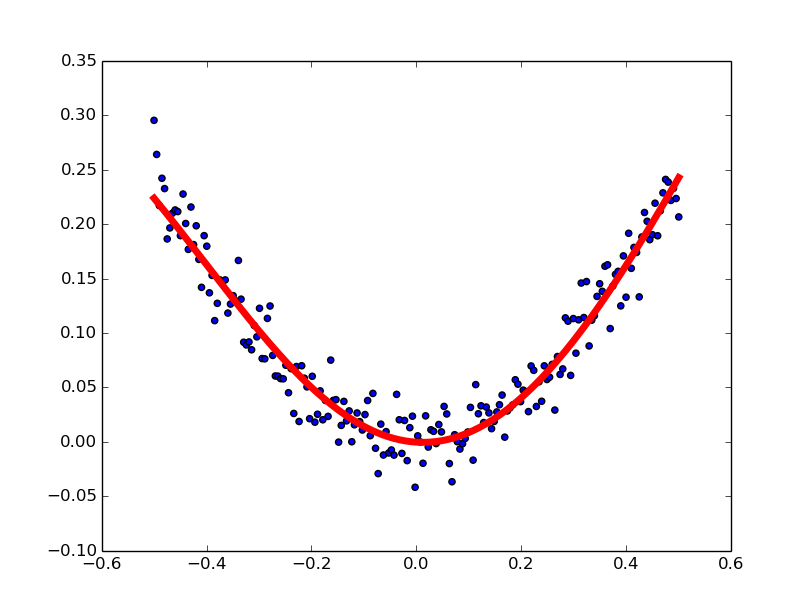Tensorflow学习教程------非线性回归
自己搭建神经网络求解非线性回归系数
代码
#coding:utf-8 import tensorflow as tf import numpy as np import matplotlib.pyplot as plt #使用numpy 生成200个随机点 x_data = np.linspace(-0.5,0.5,200)[:,np.newaxis] #x_data:200行1列 数值在-0.5到0.5之间 noise = np.random.normal(0,0.02,x_data.shape)#noise :200行1列 y_data = np.square(x_data) + noise #y_data 200行1列 #定义两个placeholder x = tf.placeholder(tf.float32, [None,1]) #x:任意行 1列 y = tf.placeholder(tf.float32, [None,1]) #y:任意行 1列 #输入的是一个数 输出的也是一个数 因此输入层和输出层都是一个神经元 #定义一个神经网络中间层 可以是任意个神经元 例如10个 #定义神经网络中间层 Weights_L1 = tf.Variable(tf.random_normal([1,10])) #1行10列 biase_L1 = tf.Variable(tf.zeros([1,10])) # 1,10 Wx_plus_b_L1 = tf.matmul(x, Weights_L1)+biase_L1 #x被正式赋值之后是200行1列 tf.matmul(x, Weights_L1)结果是200行10列 而biase_L1是1行10列 那么这俩怎么相加呢 在Python里面 200行10列的A向量+1行10列的B向量, 相当于给A向量每行加了B向量 L1 = tf.nn.tanh(Wx_plus_b_L1) #使用双曲正切函数作为激活函数 #定义神经网络输出层 Weights_L2 = tf.Variable(tf.random_normal([10,1])) biase_L2 = tf.Variable(tf.zeros([1,1])) Wx_plus_b_L2 = tf.matmul(L1,Weights_L2) + biase_L2 prediction = tf.nn.tanh(Wx_plus_b_L2) #二次代价函数 loss = tf.reduce_mean(tf.square(y - prediction)) #使用梯度下降法 train_step = tf.train.GradientDescentOptimizer(0.1).minimize(loss) with tf.Session() as sess: #变量初始化 sess.run(tf.global_variables_initializer()) for _ in range(2000): sess.run(train_step, feed_dict={x:x_data,y:y_data}) #迭代2000次之后所有的权重值都求出来了 #获得预测值 prediction_value = sess.run(prediction,feed_dict={x:x_data}) #画图 plt.figure() plt.scatter(x_data,y_data) #画出散点图 plt.plot(x_data,prediction_value,'r-',lw=5) #画出折线图 plt.show()
结果





